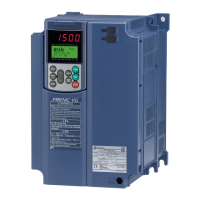5-25
• Auto torque boost
This function automatically optimizes the output voltage to fit the motor with its load. Under
light load, auto torque boost decreases the output voltage to prevent the motor from
over-excitation. Under heavy load, it increases the output voltage to increase output torque of
the motor.
• Since this function relies also on the characteristics of the motor, set the base
frequency 1 (F04), the rated voltage at base frequency 1 (F05), and othe
pertinent motor parameters (P01 through P03 and P06 through P99) in line with
the motor capacity and characteristics, or else perform auto-tuning (P04).
• When a special motor is driven or the load does not have sufficient rigidity, the
maximum torque might decrease or the motor operation might become unstable.
In such cases, do not use auto torque boost but choose manual torque boost pe
F09 (F37 = 0 or 1).
Auto energy saving operation
This feature automatically controls the supply voltage to the motor to minimize the total power
loss of motor and inverter. (Note that this feature may not be effective depending upon the
motor or load characteristics. Check the advantage of energy saving before actually apply this
feature to your power system.)
This feature applies to constant speed operation only. During acceleration/deceleration, the
inverter will run with manual torque boost (F09) or auto torque boost, depending on the F37
data. If auto energy saving operation is enabled, the response to a change in motor speed
may be slow. Do not use this feature for such a system that requires quick acceleration/
deceleration.
• Use auto energy saving only where the base frequency is 60 Hz or lower. If the
base frequency is set at 60 Hz or higher, you may get a little or no energy saving
advantage. The auto energy saving operation is designed for use with the
frequency lower than the base frequency. If the frequency becomes higher than
the base frequency, the auto energy saving operation will be invalid.
• Since this function relies also on the characteristics of the motor, set the base
frequency 1 (F04), the rated voltage at base frequency 1 (F05), and othe
pertinent motor parameters (P01 through P03 and P06 through P99) in line with
the motor capacity and characteristics, or else perform auto-tuning (P04).
F10
F11
F12
Electronic Thermal Overload Protection for Motor 1 (Select motor characteristics)
Electronic Thermal Overload Protection for Motor 1 (Overload detection level)
Electronic Thermal Overload Protection for Motor 1 (Thermal time constant)
F10 through F12 specify the thermal characteristics of the motor for its electronic thermal
overload protection that is used to detect overload conditions of the motor.
F10 selects the motor cooling mechanism to specify its characteristics, F11 specifies the
overload detection current, and F12 specifies the thermal time constant.
Thermal characteristics of the motor specified by F10 and F12 are also used for the
overload early warning. Even if you need only the overload early warning, set these
characteristics data to these function codes. To disable the electronic thermal
overload protection, set function code F11 to "0.00."
Select motor characteristics (F10)
㩷
F10 selects the cooling mechanism of the motor-- shaft-driven or separately powered cooling
fan.
Data for F10 Function
1
For a general-purpose motor with shaft-driven cooling fan
(The cooling effect will decrease in low frequency operation.)
2
For an inverter-driven motor, non-ventilated motor, or motor with separately
powered cooling fan
(The cooling effect will be kept constant regardless of the output frequency.)

